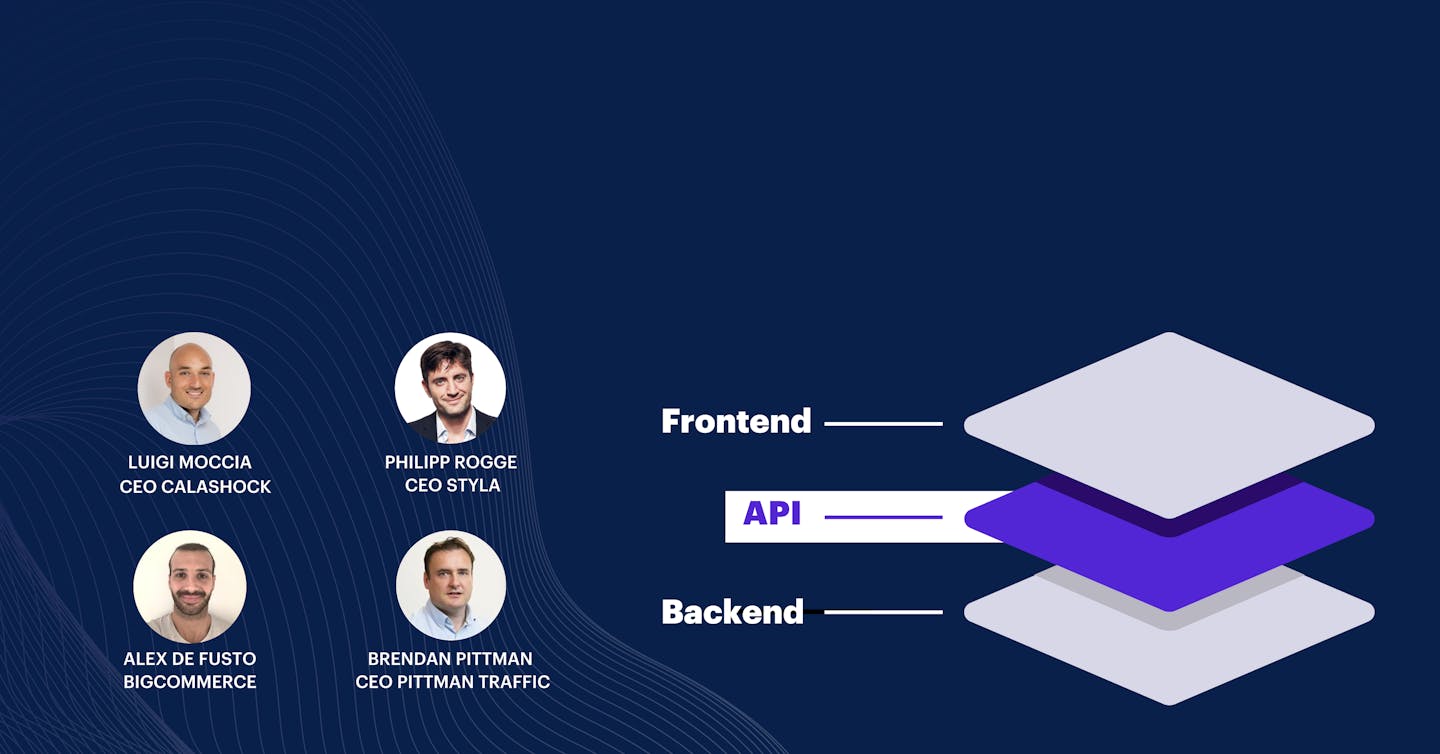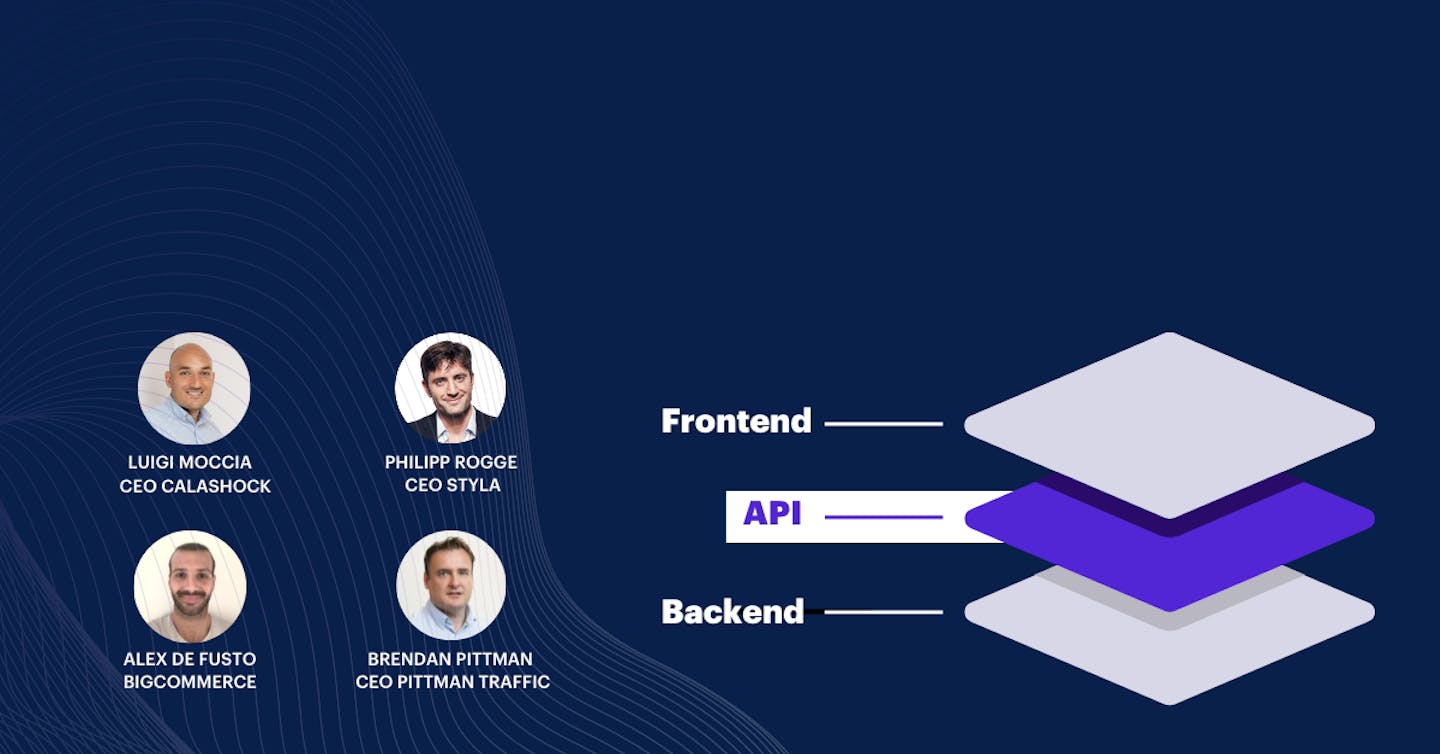Are you looking to implement a headless solution for your ecommerce?
During our Expert Talk: Mastering Headless on BigCommerce, our panel of industry experts, Luigi Moccia, CEO Calashock Commerce, Philipp Rogge, CEO Styla, Alex Defusto, Senior Sales Manager BigCommerce, and Brendan Pittman, CEO Pittman Traffic, engaged in a comprehensive discussion on headless commerce, revealing everything merchants need to know when considering going headless.
Are you looking to implement a headless solution for your ecommerce?
During our Expert Talk: Mastering Headless on BigCommerce, our panel of industry experts, Luigi Moccia, CEO Calashock Commerce, Philipp Rogge, CEO Styla, Alex Defusto, Senior Sales Manager BigCommerce, and Brendan Pittman, CEO Pittman Traffic, engaged in a comprehensive discussion on headless commerce, revealing everything merchants need to know when considering going headless.








Understanding headless commerce
In traditional monolithic commerce architectures, the frontend and backend are tightly integrated, limiting flexibility and hindering rapid innovation. While in headless commerce, the frontend, which includes the user interface and customer experience elements, is separated from the backend, which consists of the business logic, inventory management, and payment processing. This decoupling is achieved through the use of APIs (Application Programming Interfaces) that allow various systems to communicate with each other.
The growing popularity of headless commerce can be attributed to its flexibility, agility, and innovation, which are needed to stay competitive in the rapidly evolving digital landscape.
Understanding headless commerce
In traditional monolithic commerce architectures, the frontend and backend are tightly integrated, limiting flexibility and hindering rapid innovation. While in headless commerce, the frontend, which includes the user interface and customer experience elements, is separated from the backend, which consists of the business logic, inventory management, and payment processing. This decoupling is achieved through the use of APIs (Application Programming Interfaces) that allow various systems to communicate with each other.
The growing popularity of headless commerce can be attributed to its flexibility, agility, and innovation, which are needed to stay competitive in the rapidly evolving digital landscape.

“The majority of merchants consider going headless because you've got the benefit of the ecommerce platform, security, and functionality. But actually, you've got a lot more freedom on the frontend.”
Benefits of a headless architecture
- Flexibility and agility: Headless architecture allows businesses to adapt quickly to changing market demands and customer expectations. With a separate frontend and backend, companies can easily experiment with new user interfaces, channels, and touchpoints without disrupting the core ecommerce functionality.
- Enhanced customer experience: Headless commerce empowers businesses to deliver exceptional customer experiences across multiple platforms and devices. Companies can create personalized and consistent experiences that are tailored to each customer's preferences and behaviors.
- Scalability: This ensures that the ecommerce infrastructure can accommodate higher volumes of traffic, concurrent user sessions, and other growing business needs without sacrificing performance or user experience.
- Performance optimization: By separating the presentation layer from the commerce functionality, headless architecture reduces the load on the frontend, resulting in faster load times and improved overall performance.
- Integration capabilities: Headless architecture allows seamless integration with third-party systems and services. This flexibility enables businesses to leverage best-in-class solutions for specific functionalities, such as marketing automation, review management, or search solutions.
- Future-proofing: Headless commerce provides a future-proof foundation for ecommerce. Businesses can adopt emerging technologies and trends more easily, such as Progressive Web Apps (PWAs) or virtual reality shopping experiences.
Benefits of a headless architecture
- Flexibility and agility: Headless architecture allows businesses to adapt quickly to changing market demands and customer expectations. With a separate frontend and backend, companies can easily experiment with new user interfaces, channels, and touchpoints without disrupting the core ecommerce functionality.
- Enhanced customer experience: Headless commerce empowers businesses to deliver exceptional customer experiences across multiple platforms and devices. Companies can create personalized and consistent experiences that are tailored to each customer's preferences and behaviors.
- Scalability: This ensures that the ecommerce infrastructure can accommodate higher volumes of traffic, concurrent user sessions, and other growing business needs without sacrificing performance or user experience.
- Performance optimization: By separating the presentation layer from the commerce functionality, headless architecture reduces the load on the frontend, resulting in faster load times and improved overall performance.
- Integration capabilities: Headless architecture allows seamless integration with third-party systems and services. This flexibility enables businesses to leverage best-in-class solutions for specific functionalities, such as marketing automation, review management, or search solutions.
- Future-proofing: Headless commerce provides a future-proof foundation for ecommerce. Businesses can adopt emerging technologies and trends more easily, such as Progressive Web Apps (PWAs) or virtual reality shopping experiences.
Is your ecommerce business in need of a headless architecture?
While it's true that merchants can go headless at any point in their ecommerce journey and reap the benefits, here are some signs that suggest your business is in need of adopting a headless architecture:
- Complex customer experience requirements: If your company needs to deliver personalized, omnichannel experiences across multiple touchpoints (e.g. websites, mobile apps…).
- Desire for innovative frontend experiences: If your company wants to experiment with new technologies, user interfaces, or sales channels without being limited by the capabilities of a monolithic commerce platform.
- Agility and faster time to market: If your company needs to iterate rapidly, launch new features or campaigns quickly, or adapt to market trends with minimal development and deployment cycles.
- Performance and scalability challenges: If your company's existing ecommerce platform struggles to handle increased traffic, experiences slow page load times, or lacks the scalability to support business growth.
- Future-proofing strategy: If your company aims to future-proof its ecommerce infrastructure by adopting emerging technologies like PWAs.
Is your ecommerce business in need of a headless architecture?
While it's true that merchants can go headless at any point in their ecommerce journey and reap the benefits, here are some signs that suggest your business is in need of adopting a headless architecture:
- Complex customer experience requirements: If your company needs to deliver personalized, omnichannel experiences across multiple touchpoints (e.g. websites, mobile apps…).
- Desire for innovative frontend experiences: If your company wants to experiment with new technologies, user interfaces, or sales channels without being limited by the capabilities of a monolithic commerce platform.
- Agility and faster time to market: If your company needs to iterate rapidly, launch new features or campaigns quickly, or adapt to market trends with minimal development and deployment cycles.
- Performance and scalability challenges: If your company's existing ecommerce platform struggles to handle increased traffic, experiences slow page load times, or lacks the scalability to support business growth.
- Future-proofing strategy: If your company aims to future-proof its ecommerce infrastructure by adopting emerging technologies like PWAs.

“If you need unique UX, many channels, more than just ecom, if your branding team or your content team want to work in isolation and they've got lots of things to do compared to the IT team and the backend team, and you need that separation, the flexibility, then you're ready to go headless.”
Evaluating ecommerce platforms
Choosing the right ecommerce platform for headless commerce is no easy task. There are many factors to consider and many different options, which can make it difficult to choose one that will work best for your business. These are some of the most important things to consider when choosing an ecommerce platform:
- API-first architecture and headless capabilities: Ecommerce platforms with an API-first architecture provide the necessary infrastructure to support headless commerce. It should offer robust and well-documented APIs that allow seamless integration with frontend systems, third-party services, and future technologies.
- Growth Potential: As the ecommerce landscape is rapidly evolving, a reliable commerce platform should provide you with flexibility and customization options required to align with your unique business needs and adapt to changing customer demands. All while being capable of scaling effortlessly as your business grows.
- Integration options with third-party services: The platform should have integration capabilities that allow you to connect with other systems, such as marketing automation, analytics, and inventory management. This ensures seamless data flow and enables you to leverage the best solutions for different aspects of your business.
- Security and compliance: A secure platform is essential for protecting customer data, processing payments securely, and complying with relevant regulations such as GDPR (General Data Protection Regulation) or PCI-DSS (Payment Card Industry Data Security Standard).
Evaluating ecommerce platforms
Choosing the right ecommerce platform for headless commerce is no easy task. There are many factors to consider and many different options, which can make it difficult to choose one that will work best for your business. These are some of the most important things to consider when choosing an ecommerce platform:
- API-first architecture and headless capabilities: Ecommerce platforms with an API-first architecture provide the necessary infrastructure to support headless commerce. It should offer robust and well-documented APIs that allow seamless integration with frontend systems, third-party services, and future technologies.
- Growth Potential: As the ecommerce landscape is rapidly evolving, a reliable commerce platform should provide you with flexibility and customization options required to align with your unique business needs and adapt to changing customer demands. All while being capable of scaling effortlessly as your business grows.
- Integration options with third-party services: The platform should have integration capabilities that allow you to connect with other systems, such as marketing automation, analytics, and inventory management. This ensures seamless data flow and enables you to leverage the best solutions for different aspects of your business.
- Security and compliance: A secure platform is essential for protecting customer data, processing payments securely, and complying with relevant regulations such as GDPR (General Data Protection Regulation) or PCI-DSS (Payment Card Industry Data Security Standard).
BigCommerce: The Modern and Flexible Ecommerce Platform
BigCommerce: The Modern and Flexible Ecommerce Platform
BigCommerce is an ecommerce platform that provides businesses of all sizes with a robust and flexible platform to create and manage their online store. With customizable templates, advanced product management, marketing, and SEO capabilities, BigCommerce empowers businesses to build a professional and visually stunning online presence.
One of the key strengths of BigCommerce is its scalability, ensuring that businesses can handle increased traffic, high order volumes, and expanding product catalogs. Additionally, BigCommerce offers a vibrant ecosystem of apps and integrations, allowing businesses to extend the functionality of their online store with numerous third-party tools and providing a comprehensive and integrated business solution.
Partnering with the right ecommerce agency
In a headless commerce project, an ecommerce agency plays a crucial role in ensuring a successful implementation and maximizing the benefits of the headless architecture. These are some key roles and responsibilities of an ecommerce agency in a headless project:
- Strategy and planning: An ecommerce agency helps define the overall strategy and roadmap for the headless commerce project. They work closely with the client to understand their business objectives, target audience, and specific requirements. Based on this information, the agency develops a comprehensive plan for the implementation, integration, and deployment of the headless architecture.
- Technology evaluation and selection: The agency assists the client in evaluating and selecting the appropriate technologies for the headless project. This includes choosing the right headless ecommerce platform, frontend frameworks, APIs, and other supporting tools and services.
- Integration and data synchronization: One of the key challenges in a headless project is integrating various systems and ensuring smooth data synchronization between frontend and backend components.
- Ongoing support and maintenance: After the implementation of a headless solution, the agency provides ongoing support and maintenance services to ensure the system remains stable, secure, and up-to-date.
Partnering with the right ecommerce agency
In a headless commerce project, an ecommerce agency plays a crucial role in ensuring a successful implementation and maximizing the benefits of the headless architecture. These are some key roles and responsibilities of an ecommerce agency in a headless project:
- Strategy and planning: An ecommerce agency helps define the overall strategy and roadmap for the headless commerce project. They work closely with the client to understand their business objectives, target audience, and specific requirements. Based on this information, the agency develops a comprehensive plan for the implementation, integration, and deployment of the headless architecture.
- Technology evaluation and selection: The agency assists the client in evaluating and selecting the appropriate technologies for the headless project. This includes choosing the right headless ecommerce platform, frontend frameworks, APIs, and other supporting tools and services.
- Integration and data synchronization: One of the key challenges in a headless project is integrating various systems and ensuring smooth data synchronization between frontend and backend components.
- Ongoing support and maintenance: After the implementation of a headless solution, the agency provides ongoing support and maintenance services to ensure the system remains stable, secure, and up-to-date.
Calashock Commerce: Elite BigCommerce Experts
Calashock Commerce: Elite BigCommerce Experts
Calashock Commerce is a specialist BigCommerce systems integrator. With an unwavering focus on client success, their range of services, including ecommerce design and development, headless commerce development, and conversion rate optimization, are all aimed at helping businesses achieve their ecommerce goals. By partnering with Calashock, you benefit from their expertise in headless commerce as well as their commitment to innovation and cutting-edge technologies, ensuring your ecommerce solution remains future-proof and competitive in a rapidly evolving industry.
Exploring frontend solutions for your headless project
There are several frontend solutions available for adopting a headless architecture. The market offers a variety of options to choose from based on your specific business requirements.
When selecting a frontend solution for headless commerce, it is important to consider that the solution …
- … is compatible with your chosen commerce platform's API architecture, ensuring seamless integration and efficient data transfer between frontend and backend systems.
- … offers the necessary functionalities and features to deliver an exceptional customer experience.
- … provides easy integration with other systems like marketing automation, and analytics platforms, along with customization options tailored to your business needs.
- … exhibits high performance, scalability to handle increased traffic, and fast response times.
Exploring frontend solutions for your headless project
There are several frontend solutions available for adopting a headless architecture. The market offers a variety of options to choose from based on your specific business requirements.
When selecting a frontend solution for headless commerce, it is important to consider that the solution …
- … is compatible with your chosen commerce platform's API architecture, ensuring seamless integration and efficient data transfer between frontend and backend systems.
- … offers the necessary functionalities and features to deliver an exceptional customer experience.
- … provides easy integration with other systems like marketing automation, and analytics platforms, along with customization options tailored to your business needs.
- … exhibits high performance, scalability to handle increased traffic, and fast response times.
Styla Frontend: The Fastest Storefront Technology
Styla Frontend: The Fastest Storefront Technology
Styla Frontend is a flexible and customizable headless solution that allows you to create a great shopping experience for your customers. Styla removes the fuss and hassle of adding a frontend to your BigCommerce shop. The app can be installed in seconds and provides a cloud-hosted storefront from that moment on with an unbeatable page speed, best-in-class SEO, optimized conversion rates, and a no-code editor to save time and IT costs. All to boost your performance.
Styla Frontend is designed for speed and ensures lightning-fast page load times for your online store. This remarkable speed provides a superior user experience, both on desktop and mobile, leading to:
- Higher conversion rates
- Lower bounce rates and
- Improved search engine rankings
Styla Frontend is designed for speed and ensures lightning-fast page load times for your online store. This remarkable speed provides a superior user experience, both on desktop and mobile, leading to:
- Higher conversion rates
- Lower bounce rates and
- Improved search engine rankings

“What Styla does is fetch all the product information through the API and build out the entire store catalog with all the category pages and product pages. That's all done automatically, and pretty much after a few seconds, you are up and running on your super fast PWA storefront.”
Styla’s mission to democratize headless
In the current market, the available headless technologies are often costly investments, or require heavy development. These factors make this technology mostly accessible to enterprise-level companies, which have the financial and/or personnel resources to undertake such projects, leaving smaller ecommerce merchants without access to headless technology.
In order to fulfill Styla’s mission of making headless and its benefits accessible to every merchant, Styla operates as a freemium and plug-and-play solution. Styla’s freemium approach removes the huge price tag often associated with going headless, and as a plug-and-play solution, it eliminates the need for heavy development, cutting to the chase and getting users set up immediately on a complete cloud-hosted, PWA storefront.
Styla’s mission to democratize headless.
In the current market, the available headless technologies are often costly investments, or require heavy development. These factors make this technology mostly accessible to enterprise-level companies, which have the financial and/or personnel resources to undertake such projects, leaving smaller ecommerce merchants without access to headless technology.
In order to fulfill Styla’s mission of making headless and its benefits accessible to every merchant, Styla operates as a freemium and plug-and-play solution. Styla’s freemium approach removes the huge price tag often associated with going headless, and as a plug-and-play solution, it eliminates the need for heavy development, cutting to the chase and getting users set up immediately on a complete cloud-hosted, PWA storefront.
Case Study - Pittman Traffic
Pittman Traffic is a distributor of traffic and safety equipment in the UK. Their website is a critical touchpoint for engaging with their customers. However, upon its initial launch in October 2020, the website failed to match the buyer journey of their target customers, and its loading speed was notably slow.
After relaunching their online store with Styla Frontend, Brendan Pittman, CEO of Pittman Traffic, noticed remarkable improvements: an increase in conversion rates by 26%, a revenue growth of 50%, and an increase of GMV by 11%.
To learn more about Brendan's success with Styla, you can read his customer success story.
Case Study - Pittman Traffic
Pittman Traffic is a distributor of traffic and safety equipment in the UK. Their website is a critical touchpoint for engaging with their customers. However, upon its initial launch in October 2020, the website failed to match the buyer journey of their target customers, and its loading speed was notably slow.
After relaunching their online store with Styla Frontend, Brendan Pittman, CEO of Pittman Traffic, noticed remarkable improvements: an increase in conversion rates by 26%, a revenue growth of 50%, and an increase of GMV by 11%.
To learn more about Brendan's success with Styla, you can read his customer success story.

“Before we went with Styla the Google Page insights score was mid 20s out of hundred. When we went to Styla, it was stunning. It was 90+ out of a hundred on Google Page insights.That alone was worth it.”
Conclusion
Headless commerce is a game-changer for businesses looking to thrive in a rapidly evolving ecommerce market. Its flexibility and ability to meet customer demands for speed, unique user experience, personalization, and omnichannel capabilities are key factors in driving business success. However, implementing a headless solution requires careful consideration and planning. Choosing the right platform, tools, and partners is crucial for achieving a successful headless commerce project.
As Google continues to set new standards for speed and user experience, businesses that fail to embrace headless commerce will face greater disadvantages compared to those who have adapted to a headless architecture. By embracing headless commerce, businesses can stay ahead of the curve and provide their customers with exceptional experiences that drive growth and success.
Styla's freemium approach is a great solution for businesses looking to adapt a headless architecture quickly and risk-free at affordable costs. If you want to know more about Styla Frontend from first-hand experiences, read our customer stories.
Conclusion
Headless commerce is a game-changer for businesses looking to thrive in a rapidly evolving ecommerce market. Its flexibility and ability to meet customer demands for speed, unique user experience, personalization, and omnichannel capabilities are key factors in driving business success. However, implementing a headless solution requires careful consideration and planning. Choosing the right platform, tools, and partners is crucial for achieving a successful headless commerce project.
As Google continues to set new standards for speed and user experience, businesses that fail to embrace headless commerce will face greater disadvantages compared to those who have adapted to a headless architecture. By embracing headless commerce, businesses can stay ahead of the curve and provide their customers with exceptional experiences that drive growth and success.
Styla's freemium approach is a great solution for businesses looking to adapt a headless architecture quickly and risk-free at affordable costs. If you want to know more about Styla Frontend from first-hand experiences, read our customer stories.












